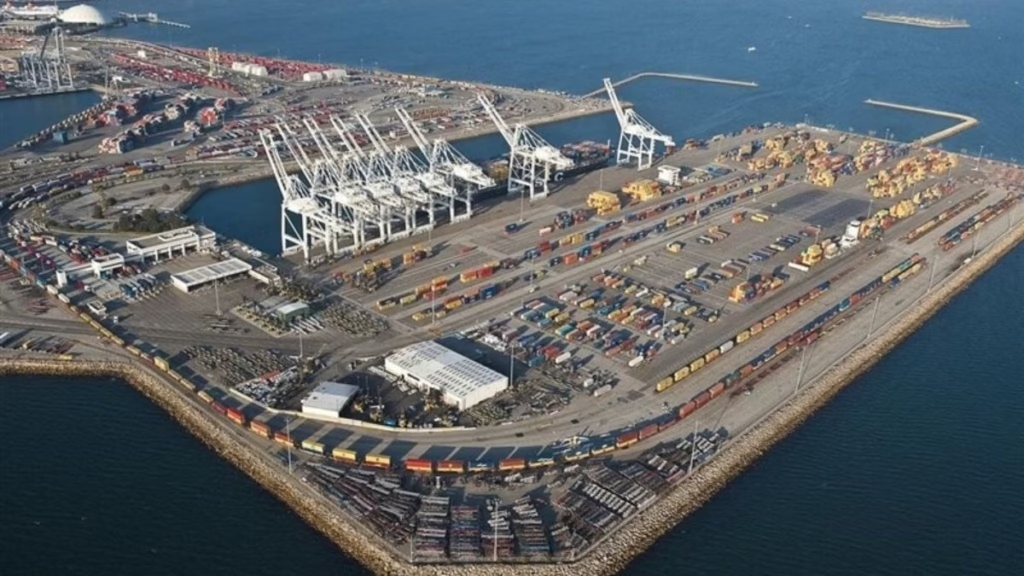Chabahar Port Back in the Spotlight: In recent weeks, the Chabahar Port in Iran has once again returned to international headlines. The development has come as a significant geopolitical twist. The very Trump administration that granted Chabahar a special waiver from U.S. sanctions back in 2018 has now reversed its position seven years later. On September 29, 2025, the strategic port located on the Gulf of Oman will be brought under the U.S. sanctions regime.
This shift carries wide-ranging implications for regional connectivity, international trade, and India’s long-term strategic vision for access to Afghanistan, Central Asia, and Europe. For years, India has invested both political and financial capital in developing the Shahid Beheshti Terminal at Chabahar. However, Washington’s unexpected recalibration threatens to derail these plans, raising uncertainty about the future of the project and the stability of India’s larger regional ambitions.
From Waiver to Blacklist: The U.S. Reversal
Back in 2018, amid its “maximum pressure” campaign against Tehran, Washington had still made one notable exception. The Trump administration exempted Chabahar Port from sanctions under the Iran Freedom and Counter-Proliferation Act (IFCA). The rationale at that time was straightforward. Chabahar was not simply an Iranian venture; it carried humanitarian and development consequences for Afghanistan. The port provided Afghanistan, a landlocked country, with access to global trade routes independent of Pakistan’s chokehold. By supporting Chabahar’s development, Washington saw an opportunity to help stabilize Kabul economically.
Fast forward to 2025, and circumstances have changed. The Trump administration, now in its second term, has decided to end this concession. Announcing the move as part of a renewed policy of “maximum pressure 2.0,” Washington has declared that Chabahar will no longer enjoy sanction exemptions. By September 29, the port’s operators and connected businesses will fall within the sanction radar, with punitive measures expected against firms dealing with the project.
For India, which had painstakingly negotiated its role in Chabahar and committed billions of dollars to its infrastructure, this decision amounts to a heavy blow. As details of the U.S. restrictions emerge, firms associated with the Shahid Beheshti Terminal may face direct risks ranging from loss of financial channels to insurance complications and disruptions in supply chain partnerships.
Trump’s Strategy: From Russian Oil to Iranian Ports
Observers note that President Trump’s latest decision is part of a larger pattern. Only months earlier, Washington had introduced sweeping curbs on Russian oil exports, targeting refiners and energy traders globally, including those in India. Now, Iran’s Chabahar port is the next pressure point. Both areas carry deep relevance for India. On the energy front, India has relied on Russian oil discounts to meet domestic energy security requirements. On the connectivity front, Chabahar stands central to India’s long-cherished idea of bypassing Pakistan to access Afghanistan and expand its economic foothold in Central Asia.
By targeting both channels simultaneously, Washington has effectively squeezed India’s two major external anchors: cheap energy from Russia and strategic market access through Chabahar.
Why India Needs Chabahar
The importance of Chabahar for India is not just economic. It is also deeply strategic. Located along the Gulf of Oman, only about 140 kilometers from Pakistan’s Karachi port, Chabahar is ideally positioned to counterbalance Pakistan’s growing partnership with Beijing on the development of Gwadar Port. Gwadar is a critical node in China’s Belt and Road Initiative (BRI), and through the China-Pakistan Economic Corridor (CPEC), it has already redrawn the map of trade and strategic influence in the region.
For India, relying on Karachi or Pakistani land routes to reach Afghanistan has always been politically unfeasible given the hostile bilateral relationship. Chabahar emerged as the alternative lifeline. From the Indian perspective, it serves as a bypass, establishing direct connectivity with Afghanistan and beyond into Central Asia and Russia, reducing dependence on Pakistan-controlled transit routes.
Moreover, the port could serve as a gateway for Indian goods to enter broader Eurasian markets. The International North-South Transport Corridor (INSTC), envisioned as a trade highway connecting India with Europe via Iran, Azerbaijan, and Russia, finds its southern pivot in Chabahar. In this sense, Chabahar is more than just a port project—it symbolizes India’s ambition for economic integration with geographies far beyond South Asia.
India’s Investments and Agreement With Iran
Recognizing this immense potential, India had made ambitious investment commitments. The government announced plans worth $8 billion to gradually develop various stages of Chabahar. In 2024, New Delhi signed a ten-year agreement with Tehran to operate part of the port and expand its infrastructure. This agreement covered the operation of a terminal at Chabahar along with financing commitments: $120 million dedicated for immediate development and $250 million in credit facilities for long-term infrastructure upgrades.
The deal was seen as a landmark in India’s regional outreach. It marked the first time that India had assumed long-term operational control of a foreign port of such magnitude, reflecting New Delhi’s growing aspiration to act as a maritime and continental connector.
The Shahid Beheshti Terminal in particular was billed as transformative, enabling greater trade movement between India, Iran, Afghanistan, and Central Asia. For many policy planners in Delhi, it was the center of gravity for India’s westward engagement strategy.
The U.S. Shock and Its Risks for India
Washington’s decision to revoke the waiver spells trouble for these plans. If U.S. sanctions fully extend to the port’s operations, Indian entities working on-site or providing critical equipment could face restrictions from global transactions. Financing options, insurance for ships docking at Chabahar, and partnerships with international logistics companies could all dry up. The ripple effect could stall India’s decade-long strategic project and make its massive financial commitments look vulnerable.
Beyond Chabahar itself, such sanctions could complicate India’s diplomatic positioning. On the one hand, India has delicate ties with Washington, especially given its place in the Quad security dialogue alongside the U.S., Japan, and Australia. On the other hand, India cannot afford to lose its access route through Iran, nor can it align fully with Washington’s maximum pressure campaign without undermining its regional interests.
This tension places India in a policy dilemma. Aligning with Washington would mean quietly shelving its Chabahar dream, which would, by extension, weaken its outreach to Central Asia. Defying U.S. sanctions could attract punitive costs, particularly at a time when India seeks greater defense and technological cooperation with the U.S.
Chabahar vs Gwadar: The Regional Contest
The timing of this American move is particularly significant given China’s progress on Gwadar. Located in Pakistan’s Balochistan province, Gwadar has been developed aggressively under the Belt and Road Initiative. It serves both commercial and military objectives, offering China a direct foothold at the Arabian Sea.
Many analysts have seen India’s involvement in Chabahar as a direct counterweight to China’s presence in Gwadar. Whereas Gwadar offers Beijing a channel into Arabian Sea logistics, Chabahar provides India with its mirror partner—a strategic location opening the door to westward trade. Now, with U.S. sanctions complicating Chabahar’s development, the balance tilts further in favor of China and Pakistan.
The Larger International Context
At the macro level, Washington’s decision is part of its ongoing effort to box Iran into deeper isolation. By choking off Chabahar, the U.S. has targeted one of Iran’s few remaining tools of economic diplomacy. Tehran had presented Chabahar as a neutral channel for regional cooperation, capable of offering landlocked countries access to international waters. By sanctioning Chabahar, the political message is clear: Tehran must not be allowed any instrument of legitimacy or connection with the global economy.
For Afghanistan, this translates into bad news. During the years of exemption, Chabahar offered Kabul an alternative route to break its dependence on Pakistani ports, which often face restrictions or political leverage. Now, Afghanistan’s already fragile economy risks losing that alternative, further reducing its ability to connect with global markets.
India’s Strategic Setback
For India, Chabahar was not just commerce but part of a broader strategy of connectivity, trade, and influence. Losing momentum on the project disrupts India’s carefully built plans to integrate into Central Asia’s energy and commodity markets. It also weakens its capacity to participate fully in trans-Eurasian corridors that could compete with China’s Belt and Road Initiative.
The setback comes despite India having nurtured this project for over a decade, working through barriers that ranged from Iran’s domestic instability to fluctuating U.S.-Iran relations. Chabahar was seen as the one project immune from these swings, thanks to the 2018 waiver. That assumption now stands shattered.
Looking Ahead: What Options for India?
As September’s sanction deadline approaches, India faces three difficult options.
- Seek a New Waiver: India could lobby Washington to carve out an exemption similar to the 2018 decision. The justification would once again center around Afghanistan’s connectivity needs and humanitarian considerations. However, given that Afghanistan’s political dynamics have changed since the U.S. exit in 2021 and its present alignment with neighboring powers, this argument may not hold as much weight as it once did.
- Continue Quietly With Iran: India could attempt to carry forward the Chabahar project with minimal exposure, relying on rupee-rial bilateral settlements and local contractors to insulate the venture from U.S. scrutiny. This, however, carries significant risk. Companies could still face repercussions, and India’s wider financial system would remain vulnerable.
- Scale Down Ambitions: The third path would be the least preferred but perhaps practical—to scale down or suspend further investments in Chabahar pending clarity. While this would preserve India’s ties with Washington, it would weaken India’s strategic presence at a time when China continues robust expansion at Gwadar.
Whatever choice India makes will reverberate far beyond the port itself. Chabahar has become symbolic of India’s broader act of balancing between superpower expectations and regional necessities.
A Wake-Up Call for India’s Westward Ambitions
The Trump administration’s decision to place Chabahar under sanctions marks a turning point in the geopolitics of South and Central Asia. Once hailed as a beacon of India’s regional outreach and a counterbalance to China’s Belt and Road, the project now faces one of its biggest existential threats.
India must carefully weigh how to navigate these stormy waters. Whether it presses Washington for exemption, doubles down with Iran, or scales back its ambitions, the choices will be difficult and consequential.
At stake is not just one port. It is the entire vision of India as a regional connector, a nation that can bridge South Asia with Central Asia and Europe by land and sea. For now, Chabahar stands as both a promise unfulfilled and a stark reminder of how global geopolitics can abruptly reshape national strategy.
Read More: Yasin Malik Drops a Bombshell: Manmohan Singh Thanked Me After Hafiz Saeed Meet




